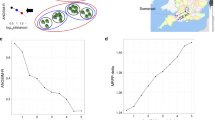Abstract
Most studies of marine bacterial communities focus on functional attributes of the community, rather than on population or community structure, at least in part, because of the difficulty in enumerating individual species within complex communities. Here, we describe a study in which populations of three bacterial species were followed over time in replicate marine enrichment cultures using 16S rRNA-based oligonucleotide probes. Three identical enrichment microcosms were established with lignin-rich pulp mill waste as a sole carbon source, inoculated with coastal seawater, and transferred at two-week intervals. Population levels were assessed throughout a six-week period using species-specific 16S rRNA-based oligonucleotide probes directed toward three bacterial species that were numerically important (and culturable) members of the enrichments. Substantial differences in the population levels of each bacterial species were found among the triplicate incubations, despite the fact that the enrichments were inoculated and treated identically. Stochastic differences in the composition of the inoculum and/or ecological interactions within the enrichment replicates may have been important in determining final population levels. Functional ability, assessed as rates of degradation of a synthetic lignin preparation, were fairly similar among the three replicate enrichments (within 70%), despite the substantial differences in population levels of the representative lignin-degrading species.
Similar content being viewed by others
References
Azam, F. & J. W. Ammerman, 1984. Cycling of organic matter by bacterioplankton in pelagic marine ecosystems: microenvironmental considerations. In Fasham M. J. R. (ed.), Flows of Energy and Materials in Marine Ecosystems. Plenum Press, New York: 345–360.
Azam, F. & R. E. Hodson, 1981. Multiphasic kinetics for D-glucose uptake by assemblages of natural marine bacteria. Mar. Ecol. Prog. Ser. 6: 213–222.
Bauer, J. E. & D. G. Capone, 1988. Effects of co-occurring aromatic hydrocarbons on degradation of individual polycyclic aromatic hydrocarbons in marine sediment slurries. Appl. envir. Microbiol. 54: 1649–1655.
Benner, R., M. A. Moran & R. E. Hodson, 1986. Biogeochemical cycling of lignocellulosic carbon in marine and freshwater 75 ecosystems: relative contributions of procaryotes and eucaryotes. Limnol. Oceanogr. 31: 89–100.
Brock, T. D., 1987. The study of microorganisms in situ: progress and problems. Symp. Soc. Gen. Microbiol. 41: 1–17.
Dwyer, D. F., F. Rojo, K. N. Timis, 1988. Bacteria with new pathways for the degradation of pollutants and their fate in model ecosystems. In Klingmüller W. (ed.), Risk Assessment for Deliberated Releases. Springer-Verlag, Berlin: 100–109.
Findlay, R. H., P. C. Pollard, D. J. W. Moriarty & D. C. White, 1985. Quantitative determination of microbial activity and community nutritional status in estuarine sediments: evidence for a disturbance artifact. Can. J. Microbiol. 31: 493–498.
Freudenberg, K. & A. C. Neish, 1968. Constitution and biosynthesis of lignin. Springer-Verlag, Berlin, 129 pp.
Giovannoni, S. J., T. B. Britschgi, C. L. Moyer & K. G. Field, 1990. Genetic diversity in Sargasso Sea bacterioplankton. Nature (London) 345: 60–63.
González, J. M., F. Mayer, M. A. Moran, R. E. Hodson & W. B. Whitman, 1997a. Microbulbifer hydrolyticus gen. nov., sp. nov. and Marinobacterium georgiense gen. nov., sp. nov., two marine bacteria from a lignin-rich pulp mill waste enrichment community. Int. J. syst. Bacteriol. 47: 369–376.
González, J. M., F. Mayer, M. A. Moran, R. E. Hodson and W. B. Whitman, 1997b. Sagittula stellata gen. nov., sp. nov., a lignintransforming bacterium from a coastal environment. Int. J. syst. Bacteriol. 47: 773–780.
González, J. M., W. B. Whitman, R. E. Hodson & M. A. Moran, 1996. Identifying numerically abundant culturable bacteria from complex communities: An example from a lignin enrichment culture. Appl. envir. Microbiol. 61: 4433–4440.
Haider K. & J. Trojanowski, 1975. Decomposition of specifically 14C-labeled phenols and dehydropolymers of coniferyl alcohol as models for lignin degradation by soft and white rot fungi. Arch. Microbiol. 105: 33–41.
Hobbie, J. E., R. J. Daley & S. Jasper, 1977. Use of Nuclepore filters for counting bacteria by fluorescence microscopy. Appl. envir. Microbiol. 33: 1225–1228.
Jørgensen, B. B. & T. Fenchel, 1974. The sulfur cycle of a marine sediment model system. Mar. Biol. 24: 189–201.
Kaushik, N. K. & H. B. Hynes, 1971. The fate of the dead leaves that fall into streams. Arch. Hydrobiol. 68: 465–515.
Lane, D. J., B. Pace, G. J. Olsen, D. A. Stahl, M. L. Sogin & N. R. Pace, 1985. Rapid determination of 16S ribosomal RNA sequences for phylogenetic analyses. Proc. natl. Acad. Sci. U.S.A. 82: 6955–6959.
Mason, C. F., 1976. Relative importance of fungi and bacteria in the decomposition of Phragmites leaves. Hydrobiologia 51: 65–69.
Mitchell, J. G. & J. A. Fuhrman, 1989. Centimeter scale vertical heterogeneity in bacteria and chlorophyll a. Mar. Ecol. Prog. Ser. 54: 141–148.
Pratt, J. R., N. J. Bowers, B. R. Niederlehner & J. Cairns, Jr., 1988. Effects of chlorine onmicrobial communities in naturally derived microcosms. Envir. Toxicol. Chem. 7: 679–687.
Søndergaard, M. & M. Middelboe, 1995. A cross-system analysis of labile dissolved organic carbon. Mar. Ecol. Prog. Ser. 118: 283–294.
Spain, J. C., P. H. Pritchard & A. W. Bourquin, 1980. Effects of adaptation on biodegradation rates in sediment/water cores from estuarine and freshwater environments. Appl. envir. Microbiol. 40: 726–734.
Vicuña, R., 1988. Bacterial degradation of lignin. Enz. Microb. Technol. 10: 646–655.
Wagner-Döbler, I., R. Pipke, K. N. Timmis & D. F. Dwyer, 1992. Evaluation of aquatic sediment microcosms and their use in assessing possible effects of introduced microorganisms on ecosystem parameters. Appl. envir. Microbiol. 58: 1249–1258.
Zimmermann, W., 1990. Degradation of lignin by bacteria. J. Biotechnol. 13: 119–130.
Zweifel, U. & A. Hagström, 1995. Total counts of marine bacteria include a large fraction of non-nucleoid-containing bacteria (ghosts). Appl. envir. Microbiol. 61: 2180–2185.
Author information
Authors and Affiliations
Corresponding author
Rights and permissions
About this article
Cite this article
González, J.M., Hodson, R.E. & Moran, M.A. Bacterial populations in replicate marine enrichment cultures: assessing variability in abundance using 16S rRNA-based probes. Hydrobiologia 401, 69–75 (1999). https://doi.org/10.1023/A:1003771318693
Issue Date:
DOI: https://doi.org/10.1023/A:1003771318693




